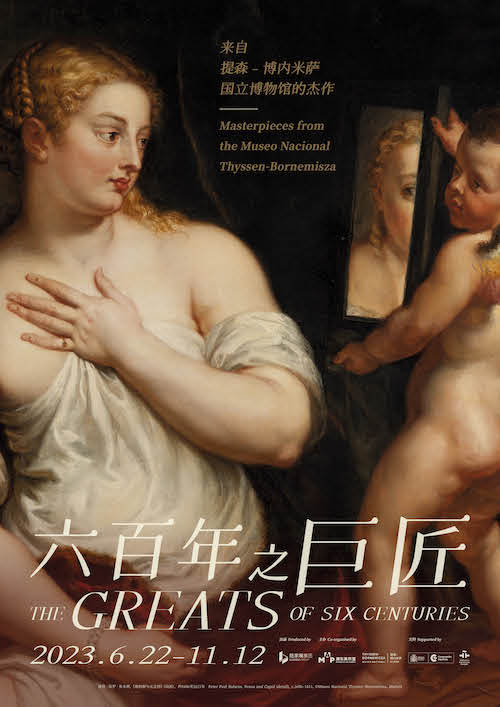
 Press Center
Press Center
On June 22, 2023, Museum of Art Pudong (MAP) proudly unveils The Greats of Six Centuries: Masterpieces from the Museo Nacional Thyssen-Bornemisza. Presenting treasured paintings from Museo Nacional Thyssen-Bornemisza of Madrid (Thyssen Museum), the exhibition sits on MAP’s second floor with eight themed sections that span six centuries. Together, the artworks, all of which are making their debut in China, form a tableau of Western art from the Renaissance to post-war European and American art, leading local audiences to revisit how life and society in the West have changed over the past 600 years. Being MAP’s first-ever painting-only exhibition, as well as the Thyssen Museum’s first international exhibition of significant magnitude since its inauguration, The Greats of Six Centuries is produced by Shanghai Lujiazui Development (Group) Company Limited, and co-organised by Museum of Art Pudong and Museo Nacional Thyssen-Bornemisza of Madrid. With this magnificent art feast, MAP once more celebrates a full house of exhibitions.
A Journey of Art Beyond Time and Space to Converse with Nearly 70 Master Artists
Promising a visual feast transcending time and space, The Greats of Six Centuries gathers 70 masterpieces by nearly 70 luminaries, including Raphael, Peter Paul Rubens, Édouard Manet, Vincent van Gogh, Wassily Kandinsky, Marc Chagall, Georgia O’Keeffe, and Andrew Wyeth, all of whom are well-known European or American artists among Chinese audiences.
The exhibition chronologically traces the development of Western art from the 15th to the 20th centuries, encapsulating a plethora of pivotal art movements and styles including Renaissance, Mannerism, Baroque, Rococo, Romanticism, Realism, Impressionism, Post-Impressionism, Expressionism, Cubism, Futurism, Russian Avant-Garde, American Modernism, Art Informel, Pop Art, American Realism, etc., thereby manifesting a condensed yet rich chronicle of Western painting.
This curated selection of works features an array of the Thyssen Museum’s most cherished masterpieces: Portrait of a Young Man by Raphael, one of three artists at apogee of High Renaissance, reflects the quintessence of that time, wielding a palette of predominantly subtle hues and the delicate light effects. Venus and Cupid by Peter Paul Rubens, a prominent Flemish Baroque painter, exudes vitality and voluptuousness, characteristic of his narrative paintings. The Grand Canal from San Vio, Venice by Canaletto, famous for his spectacular scenes of 18th-century Venice, depicts grand topographical views of the city showing both urban landmarks and aspects of Venetians' daily lives. The Water Stream, La Brème, executed by Gustave Courbet during the final stage in his career, captures the particular characteristics of the scenery with utmost trueness to life, yet retaining his subjective conception of painting. The Stevedores in Arles by Post-Impressionist legend Vincent van Gogh hints at a shift in his style, as he eschewed pointillist and Impressionist methods in favor of more synthetic forms and louder colours to express emotions. And in the painting, The Madonna of the Village by Marc Chagall, the “godfather” of Surrealism evokes a dreamy, fantastical realm through his depiction of the holy mother with child surrounded by angels.
Also worthy of particular mention is Horsewoman, Full-Face, a masterpiece by Édouard Manet, often cited as the father of Modernism. Thanks to Manet’s technique of free brushstrokes, the horsewoman shows an androgynous look in apparent spontaneity and freshness, with her black costume revealing the artist's magical mastery of black tones, and the pursuit of luminosity that goes hand in hand with a study of colored surfaces, outlines and textures. Back in 2011, the piece was featured as a highlight in Manet, the Man Who Invented Modernity hosted at the Musée d'Orsay, and was chosen as the key visual poster that drew widespread interest on the streets of Paris. The painting, stating the image of modern Parisian ladies in the 19th century, will inevitably become a memorable highlight at the MAP exhibition, resonating with local audiences in modern Shanghai.
The exhibition also illuminates underappreciated masterpieces. Among them, Murnau: Top of the Johannisstrasse by Wassily Kandinsky crystallizes the pivotal period of the artist's metamorphosis, deconstructing the urban milieu into essential shapes—an important prelude to his path towards Abstractionism. The Yellow Flowers is a vibrant testament to Henri Matisse's somber period, filled with color and energy, presaging the bold emergence of Fauvism. The Junkerboden under Snow by Ernst Ludwig Kirchner, a founder of the Expressionist group The Bridge, echoes the Alps's cultural resonance, a tradition that stretches back to Romanticism while marking the close of Kirchner’s artistic journey. and From the Plains II, born from the brush of Georgia O’Keeffe, the mother of American Modernism in her late years, magnificently surpasses its original version which was made 35 years ago in capturing the expansive beauty of the Texas plains. Displayed collectively under the same roof, these masterpieces offer an enriching exploration into the profound creativity of these renowned artists and a revealing narrative of the evolution of their respective careers.
A Western Art Encyclopedia of Eight Sections and across Six Centuries
Divided into eight sections, The Greats of Six Centuries features masterpiece paintings spanning six centuries as the title suggests. They cover diverse genres including portrait, landscape, still life, and customs, taking local audiences on a journey in search of knowledge – from the Renaissance to the 19th century, the art quest was oriented, by different paths, towards objective reality, before a change of direction towards the subjective that eventually would lead to abstract art at the end of the 19th century, only to return to figurative realism in the second half of the 20th century. Therefore, the exhibition, curating classic works from various periods, can be seen as a de facto “encyclopedia of Western painting”.
With portraiture being the most symbolic painting genre at the Thyssen Museum, portraits are naturally most fit to open the MAP exhibition. The section “Faces of the Renaissance: Portraiture in Northern and Southern Europe” focuses on portraits between 1450 and 1550, explaining how portraiture became an independent genre that separated from religious compositions during the Renaissance. Next, “Baroque Painting: Realism and Emotion” presents the 17th-century painting scene in the Netherlands, where the development of the art market pushed painters to specialise and ignited a proliferation of painting genres: landscape, interiors, peasant scenes... And “The 18th Century in Europe: Views, Landscapes, Portraits and Other Themes” is dedicated to the face of Italian, French, and English paintings in the 18th century, when the sensibility of the period developed between two poles – theatricality and intimacy.
Into the 19th century, Paris became the center of European art and Western painting. “19th Century in Europe: French Realism and Impressionism” examines modern life in France – compared with Realism which emphasizes depicting the real and objective, Impressionism prioritizes subjective perception and the ephemeral moment. Another time-parallel section “American 19th-Century Painting” looks at the similar evolution of American Impressionist and landscape paintings, highlighting a period in which landscape painting reaffirmed the national spirit through the mythification of landscape.
The last three sections of the exhibition are all devoted to 20th-century Western painting. In “20th Century in Europe: Expressionism”, works from several best-known Expressionist groups: the Fauves, The Bridge, and The Blue Rider as well as those by Russian Avant-Garde artists are highlighted. The follow-up section, “20th Century in Europe: The Cubist Tradition” unravels how Cubism destructs and reconstructs forms analytically while looking at the rise and development of abstract art. In wrapping up the whole exhibition, “Postwar European and American Art” illustrates how New York became the new center of art, looking at the triumph of abstraction, both in its geometric and informalist versions in the West and the gradual emergence of the return to figurative realism.
First Large-Scale Exhibition by the Thyssen Museum to Enrich Fine Art Education
The Thyssen Museum collection was founded by Heinrich Thyssen, son of the German coal and steel magnate August Thyssen. After completing his first major acquisition in 1926, Heinrich continued to purchase reputed works by masters from different genres. After his passing in 1947, his son Hans Heinrich, “Heini”, inherited his businesses and most of his art collection, and took a decisive step in 1961 to start collecting modern paintings, which his father had always ignored. So the collection serves as living proof to the passion and commitment of two generations.
The Thyssen Museum opened in Madrid in October 1992, before the collection was acquired by the Spanish government shortly afterward. It has now become a key component forming Madrid's Golden Triangle of Art. As the Thyssen Museum comes to China for the first time with some of its most treasured pieces, The Greats of Six Centuries also marks the first time that the museum has showcased its painting collection on such a scale outside of Spain.
With the exhibition, a Western art encyclopedia consisting of 70 highly-appreciated examples unfolds a journey of beauty in front of local audiences, vividly depicting the evolution of concepts and perspectives over time. By revealing the commonality of art, these masterpieces also help local audiences discover their connection with present-day life, while the passage of time, the alternation of civilizations, and the changes in art are all themes celebrated by this exclusive art feast spanning 600 years.
The curatorial team has placed the exhibition in three galleries with a total area of 1,600 square metres, which is the main stage for dialogue between the masterpieces and the local audience. There, the exhibition implements an advanced and meticulous lighting design to present these 70 paintings in a setting that accentuates an impressive experience and a deeper connection with its audience. Roaming in the space, viewers are able to more than clearly examine every detail of the masterpieces, but dive into the unique temperament of the times they reflect as well. And to facilitate better viewing experience on this extraordinary journey beyond time and space, MAP has also complied a content-rich- guidebook that will be distributed to viewers free of charge to explain the key works in detail.
Moreover, the entrance to the exhibition displays a chronological timeline that traces the exhibited collection via the evolution of art. Starting from the Renaissance, the timeline also includes the introduction and evolution of major painting styles and schools, helping audiences better understand the development of Western art from different perspectives. And the exhibition also seeks to be more informative with well-designed scenographic settings: key elements and details of the exhibited paintings are excerpted and enlarged for additional interpretations, echoing the timeline while enriching the viewing experience.
In order to activate MAP’s educational functions and expand the audiences, various public education activities facing different groups will also be launched during the exhibition. On the first day of public viewing, 22 June, the Artistic Director and Managing Director of the Museo Nacional Thyssen-Bornemisza will hold a conversation with the Chairman of the Museum of Art Pudong to discuss the exhibition's behind-the-scenes stories and museum management. This will be followed by a fascinating lecture by the Artistic Director of Thyssen Museum on the evolution of Western painting in relation to the core masterpieces of this exhibition. Through a wide range of activities, MAP will bring local audiences closer to the master artists, and embark on a 600-year journey of brilliant art.
【The Greats of Six Centuries: Masterpieces from the Museo Nacional Thyssen-Bornemisza Exhibition Poster】

About Museum of Art Pudong
Located at the heart of Xiao Lujiazui, the Museum of Art Pudong (MAP) broke ground on September 26, 2017, and opened to the public in July, 2021.
Invested, built, and managed by the Lujiazui Group and designed by Ateliers Jean Nouvel (AJN), MAP is primarily set out to present world-class exhibitions to its audience as well as showcasing domestic artists. The four major functions of MAP include: to hold exhibitions, to promote art education, to develop cultural merchandises, and to advocate for international exchange. MAP aims to become a new cultural landmark of Shanghai and an important platform for international cultural exchange.
About the Museo Nacional Thyssen-Bornemisza
Museo Nacional Thyssen-Bornemisza opened to the public for the first time in 1992. The family tradition of collecting was established when August Thyssen commissioned marble sculptures from Auguste Rodin. Afterward, with the continuous efforts of the next two generations of Baron Thyssen, the collection became known for its around 800 paintings by prestigious names in the history of Western painting.
Museo Nacional Thyssen-Bornemisza together with the Museo Nacional del Prado and Museo Nacional Centro de Arte Reina Sofía forms the famous "Golden Triangle of Art" in Madrid.
 PREV
PREV

 沪公网安备 31011502017932号
沪公网安备 31011502017932号



